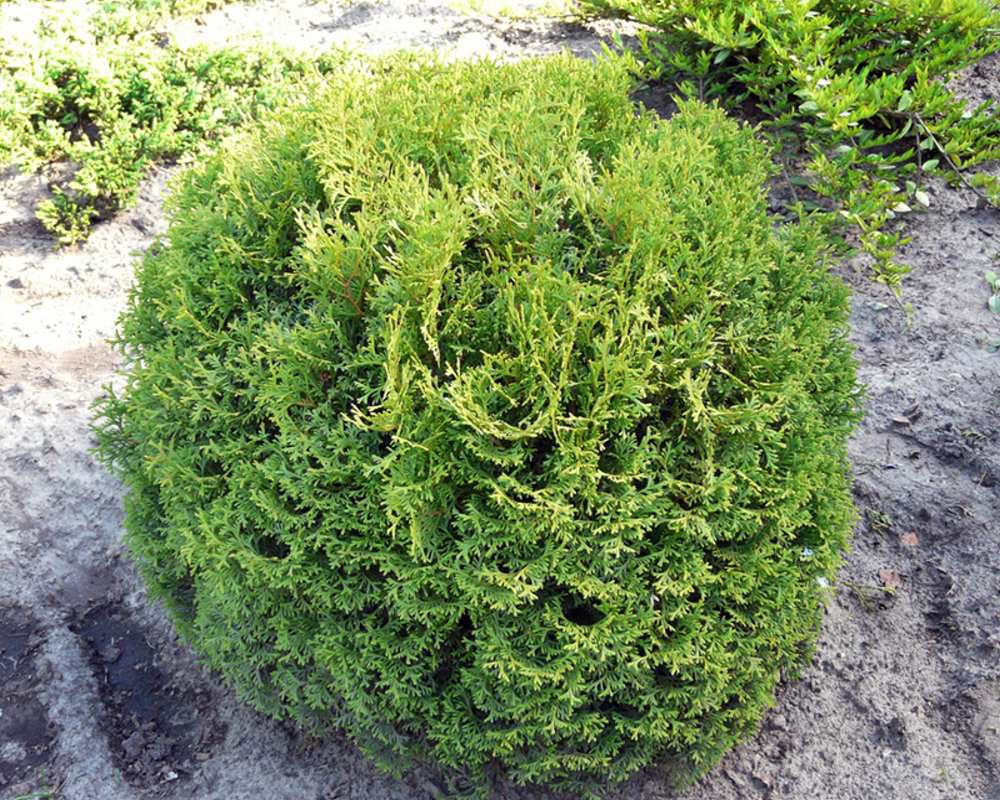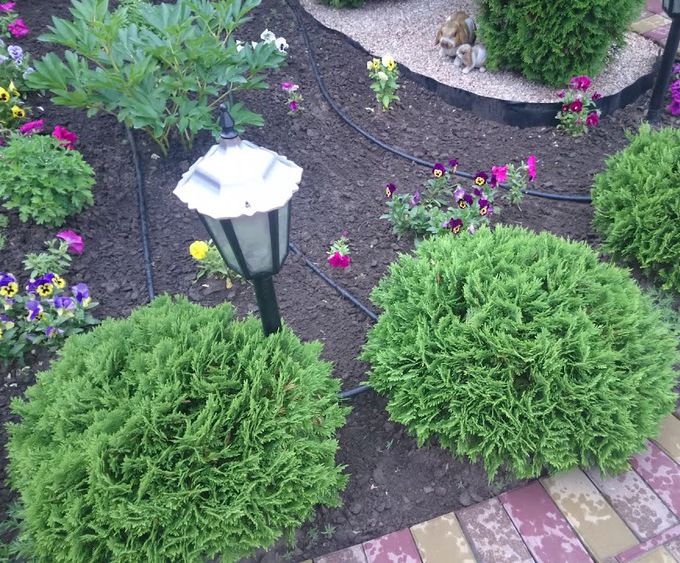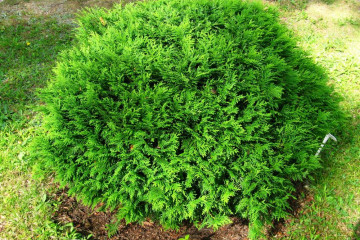Tuya Tini Tim (Tiny Tim) western - description
Content:
The dwarf variety of western thuja Tiny Tim is a beautiful evergreen shrub used in landscaping gardens and parks. Rounded low crown, small annual growth, unpretentiousness distinguish the breed from demanding large-sized ones.
Description of western thuja Tiny Tim (Tiny Tim)
The plant belongs to the species Thuja Occidentalis. The variety was first presented to the general public in 1935. Its modest dimensions and undemanding soil make it possible to plant the bush wherever there is enough light and there is an area of 100 × 100 cm.
Description and dimensions
Buyers are attracted to this ornamental shrub by its neat lush crown, which has the shape of an almost regular ball. As the thuja grows, it will stretch up to 1 m in height, and in width will not exceed 1.5 m. The shoot is short with numerous lateral processes. The bark is reddish, and the old gray-brown, flaking. The leaf looks like a dark green flake in summer and takes on a bronze tint after the onset of frost.
How fast is Tiny Tim's thuja growing
An adult plant at the age of 10 years reaches only 30 cm in height and no more than 40 cm in width. This variety is distinguished by good drought resistance, and also perceives the humid atmosphere well in areas with a large amount of summer precipitation. Compactness and dense crown are important characteristics that allow the ephedra to tolerate winter colds down to -37-39 ° С.
In nurseries, seedlings from two years old are usually presented. The older the planting material, the better and higher the chances of excellent survival. A full-fledged crown with numerous lignified shoots at Tiny Tim begins to form only at the age of 10, and until that time it looks more like a lush green annual.
Planting and leaving
The place for disembarkation is chosen in the light, but shelter from strong winds is definitely needed nearby. The soil requires nutritious and very loose. Therefore, only the mixture that was prepared in advance specifically for the thuja is poured into the dug planting hole.
The root system of Tiny Tim needs air access, loves frequent watering. In heavy, damp and overly compacted soil, the roots will be difficult to develop. With waterlogging, such typical problems as bacterial rot, as well as various fungal diseases, appear. Overdried soil can give the same effect.
How to plant Tuya Tini Tim
This variety can be used in single planting as well as for continuous dense curbs. Depending on this, single planting pits or trenches are made. The size depends on the age of the seedlings, but they always make a small margin to fill the root space with high-quality soil. Peat and sand (1 part each) are mixed to the soil (2 parts). Under each thuja, 50 g of a complex mineral fertilizer intended for conifers is applied.
If a low-lying area is selected for planting, where there is a high probability of accumulation of melt or rain water, then a 10-20 cm layer of drainage from small pebbles, expanded clay, broken brick or coarse sand is poured onto the bottom of the planting pits and trenches.
To avoid skewing the bush, a pole is stuck to the bottom of the holes before planting, to which the thuja is neatly tied up near the ground. After filling the hole, be sure to carry out abundant watering in order to see how much the soil will settle, and, if necessary, add more.
Watering mode
During the heat, the soil under the ephedra should not dry out completely, this can lead to overheating of the roots. For irrigation, use warm, settled water. Moreover, it is poured not only at the root, but also on the needles, using a shower head on a watering can.
With a lack of moisture, the crown fades. The needles need regular moisture. Signs of her good condition are light sheen and firmness. About 10 liters of water is poured under the bush per week, but in very hot weather, more may be required.
Top dressing
If during planting a sufficient amount of mineral fertilizer was applied, then in the next 2-3 years no additional fertilizing of the thuja will be required. In the future, every spring, 50-60 g of mineral fertilizer for conifers is introduced into the root space. For group planting, the consumption will be 100 g per 1 m². If you follow these recommendations, the crown will look magnificent and without signs of wilting. Once a season, you can add organic matter: compost or rotted manure.
Features of summer care
The most important thing in the summer heat is to monitor soil moisture. It should be regularly moisturized, but not waterlogged. Young bushes are watered, depending on the weather, up to three times a week. Adult plants (over 10 years old) do not need such frequent watering, 2-3 times a month is enough. The next day after watering, the soil around the trunk is loosened, but no more than 10 cm deep, so as not to damage the roots.
In order not to water too often, sprinkle the soil with mulch. Small wood chips are suitable, as well as peat. As a result, the layer should be thick enough, at least 5 cm.
Preparing for winter
Adult bushes easily tolerate even the most severe frosts, but for young seedlings it is worth organizing a shelter for winter. This will save young twigs from breakage, while retaining all the decorative effect of the crown. Cover with burlap or other breathable material. They remove the shelter only after the snow has completely melted to prevent sunburn of the needles. It is best to do this on a cloudy and calm day.
Reproduction
Thuja is propagated by a simple seed method to fully preserve its characteristics. The seeds are extracted from dried buds, which should open up on their own. They should be planted in open ground in the place of future growth at the moment when frosty weather has established and snow has fallen.
In the spring, mineral fertilizers are applied over the planting, watered as necessary. If the spring is very late, then after the snow melts, the bed is covered with a film. In such conditions, seedlings will appear sooner. As soon as the seedlings hatch, the shelter is removed in order to timely remove weeds and water.
You don't need to dive. You can remove excess plants no earlier than after 3 years. The fact is that this variety of western thuja grows very slowly in the early years. Young plants are threatened by drought, strong wind, pests and other adverse factors. To increase the chances of getting beautiful and strong bushes, leave all seedlings.
Propagation by cuttings
To obtain planting material, a healthy, beautiful plant with a symmetrical crown is chosen. A side branch is cut off from it with a sharp tool, trying to cut it off with a piece of wood.The optimal time for grafting is March, when the bush is preparing for sap flow.
The cuttings are placed in a glass of clean water. A drug that stimulates root formation is also added there. After 10 hours, the prepared planting material is placed in containers with soil.
To provide the cuttings with the necessary moisture, they are covered with a glass or film cap. They remove it only after the appearance of young shoots on the cuttings.
Why does Thuja Tini Tim turn yellow
Thuja acquires an extremely unsightly appearance when its needles lose their healthy green color with a light waxy bloom. Yellowness is a symptom of serious problems. Considering how slowly the crown grows, yellowing, even with all the measures taken, will persist for a long time.
Deformation of the cones, the appearance of yellow needles on the crown is a sign of drying out of the roots. It is important to increase moisture, always accompanying it by loosening the soil.
Too much mineral fertilizers in the soil can cause root burns. If this happens, then the crown turns yellow, and then dries out quickly. Sometimes the same symptoms appear when the ephedra is affected by thuja aphids. Insects damage the lowest shoots first. You need to deal with the problem quickly, treating the branches with karbofos.
Western thuja is a slowly growing ephedra, which for many years gives a garden or flower bed an elegant look. In landscape design, it is used almost everywhere, except for the regions of the Far North. The variety is unpretentious to care for, so even a novice gardener can grow a bush.




















